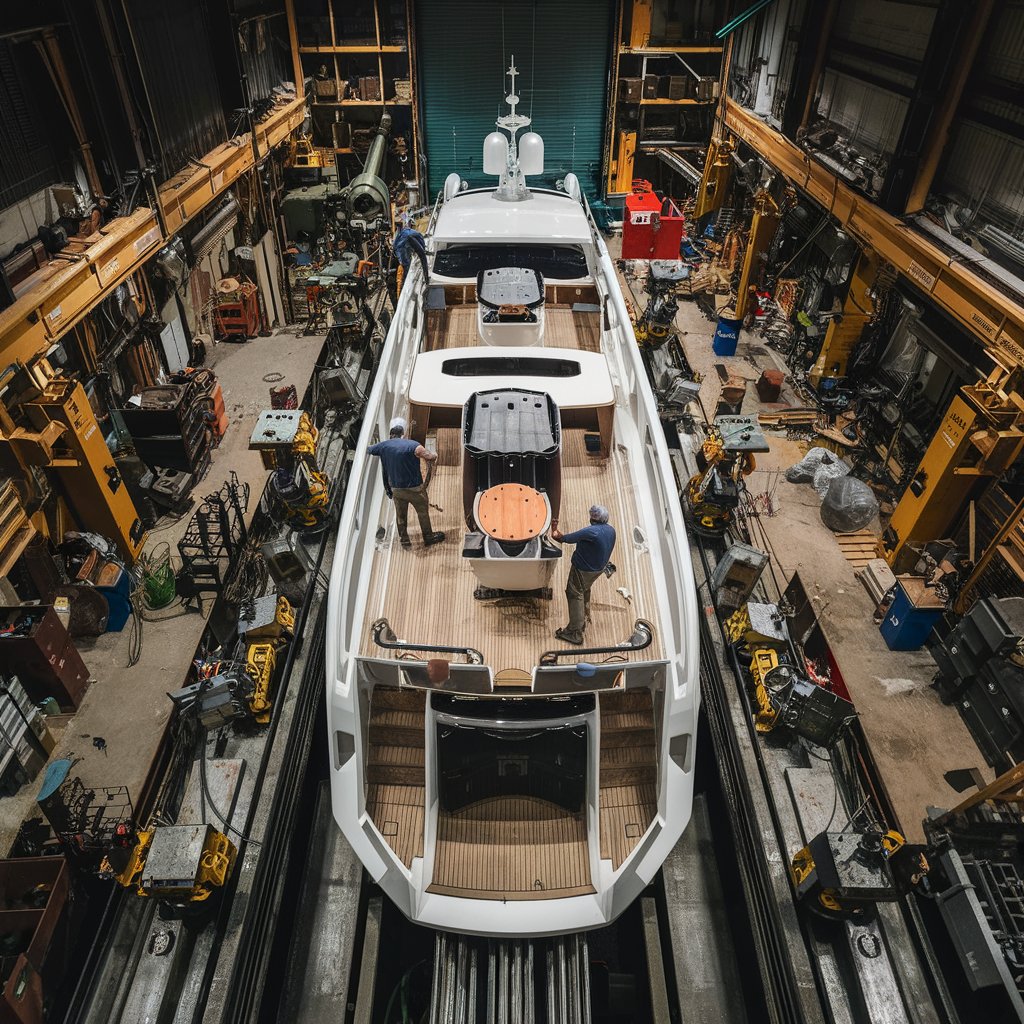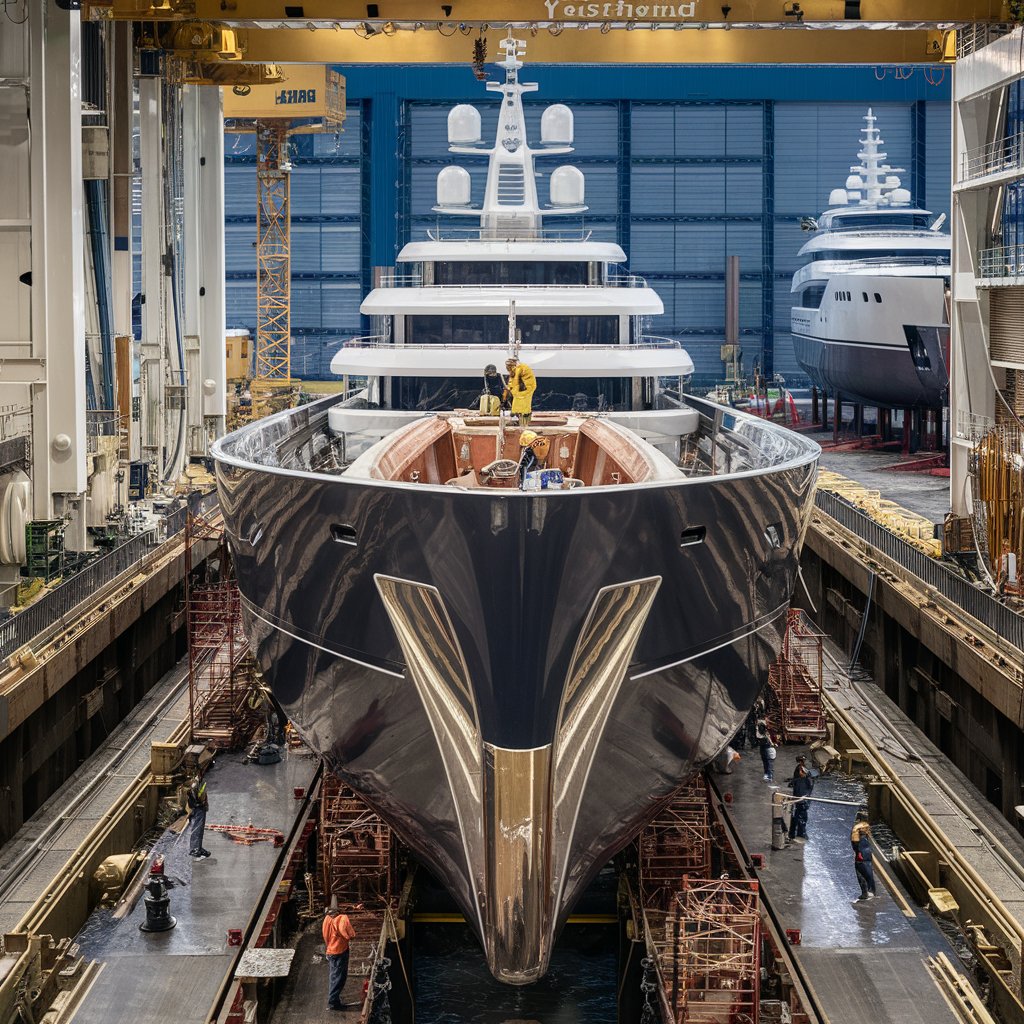Series: ”Behind the Scenes”
Introduction
Managing a shipyard requires a unique blend of technical expertise and leadership, akin to painting a masterpiece while conducting a symphony. Every brushstroke and musical note contributes to the final outcome. Coordinating various departments—such as design, engineering, construction, and finishing—each aspect must be meticulously managed to ensure that every yacht project progresses smoothly.
Technical know-how is crucial in a shipyard. Understanding every aspect of maritime engineering ensures that no stone goes unturned. Yet, expertise alone won’t steer the ship; strong leadership skills are essential to managing the workforce. This includes motivating teams, resolving conflicts, and making decisions that balance quality with timelines.
Coordinating the workflow between teams is a significant responsibility. Designers envision the yacht’s sleek curves, while engineers focus on turning these dreams into practical blueprints. Construction crews bring these plans to life, meticulously crafting the yacht’s structure, and the finishing team ensures every detail resonates with luxury and functionality.
Mastering the Craft: The Expertise of Technicians at a Yacht Shipyard

Quality control is non-negotiable in this industry. Every step of the process demands precision, as a minor mistake can cascade into bigger issues later on.
Shipyards, known for their high-intensity work environments, can pose significant dangers, as demonstrated by incidents like the fire at Lürssen shipyard on July 3rd, 2024. The construction and repair of massive yachts involve complex operations, often with hazardous materials and heavy machinery. Any oversight or accident, such as the fire that engulfed a superyacht under construction, can quickly escalate, leading to extensive damage and potential harm to workers. This incident underscores the critical need for stringent safety protocols and constant vigilance to prevent such catastrophic events in shipyards.
Ensuring Safety Amidst the High-Stakes Environment of Shipyards: Lessons from One Notable Shipyard

Implementing rigorous quality checks at every stage ensures that the final product is a vessel of exceptional design and engineering.
Time management is one of the trickiest aspects. While building yachts isn’t a race, deadlines matter. Clients expect their yachts to be ready for the season, and delays can be costly. Balancing these timelines with maintaining high-quality craftsmanship requires careful planning and flexibility. Cross-departmental meetings and regular updates help catch potential issues early, ensuring smoother progress. Being proactive, rather than reactive, is key to keeping projects on track.
This role shapes the entire shipyard’s operations, balancing technical expertise with leadership and teamwork. The challenges are significant, but seeing a yacht set sail makes every bit of the effort worthwhile.
Unveiling Opulence: The Majestic New Superyacht Makes Its Grand Debut

What are the Parts of a Shipyard?
A shipyard is a sprawling complex that encompasses various specialized areas, each crucial to the yacht-building and refitting process. The main components of a shipyard include dry docks, slipways, workshops, storage areas, and offices.
- Dry Docks: These are large, water-filled basins where yachts are constructed or repaired. They can be drained to allow workers access to the vessel’s hull, enabling them to carry out essential work below the waterline.
- Slipways: Inclined surfaces where yachts are launched into the water. They allow for the controlled movement of vessels from land to sea and are also used for pulling yachts out of the water for maintenance.
- Workshops: These are the backbone of the shipyard, housing various trades such as welding, carpentry, and electrical work. Each workshop is equipped with specialized tools and machinery necessary for fabricating and assembling different yacht components.
- Storage Areas: These include both open and enclosed spaces where raw materials, spare parts, and completed components are stored. Proper storage is critical to maintaining the quality and readiness of materials needed for construction.
- Offices: The administrative hub of the shipyard, where project management, design, engineering, and logistical coordination take place. These spaces are essential for planning, monitoring progress, and ensuring smooth communication across the shipyard.
Together, these parts of a shipyard function in harmony to facilitate the intricate process of yacht construction and maintenance, ensuring that each vessel meets the highest standards of quality and performance.

Unlock your business’s full potential with Omniconvert! Our cutting-edge platform offers advanced customer analytics, A/B testing, and personalized marketing solutions to boost your conversion rates and drive sustainable growth. Transform your data into actionable insights, optimize your customer journey, and watch your revenue soar. Click HERE and see why top companies trust Omniconvert to elevate their online performance.

The Workforce: The Artisans and Technicians Behind the Craft
A shipyard’s true strength lies in its workforce, a diverse team of highly skilled artisans and technicians, each bringing unique talents to the table. From naval architects and marine engineers to welders, electricians, carpenters, and painters, every role is crucial.
Naval architects and marine engineers are the masterminds behind the yacht’s initial design phase. These visionaries take conceptual ideas and convert them into detailed blueprints that guide the entire construction process. Their precision and innovative thinking lay the groundwork for the vessel.
Crafting Elegance: Engineers Shape the Future of Luxury at Sea


In the construction phase, welders and fabricators meticulously piece together the yacht’s framework. With every weld and joint, they ensure the structural integrity and safety of the vessel, leaving no room for errors. As the yacht takes shape, carpenters craft the iconic, luxurious interiors. These craftsmen bring life to spaces through their attention to detail and mastery of materials. From rich wooden panels to custom furniture, they’re responsible for creating the yacht’s sumptuous living quarters.
Electricians and plumbers play a crucial role in outfitting the yacht with essential systems, installing everything from electrical wiring to plumbing systems, ensuring the vessel is both functional and reliable. Finally, painters add the aesthetic finishing touches, transforming the structure into a polished masterpiece. The exterior gleams in the sun, and the Interiors showcase Opulence and Style. Their attention to detail makes each yacht a unique work of art.
Whether a seasoned veteran in yacht construction or new to the field, understanding these roles highlights the incredible expertise and effort that goes into every yacht. It’s a team effort where every craftsman’s skill is indispensable. Indeed, the intricacies of running a yacht shipyard not only involve meticulous craftsmanship and engineering but also navigating the Global Economy’s Impact on material sourcing, skilled labor availability, and market demand for luxury vessels.
Popular Yachting Shipyards
Some of the most renowned shipyards in the yachting world include Feadship, Lürssen, Benetti, and Oceanco. These shipyards are known for their exceptional craftsmanship and have produced some of the most iconic yachts in history.
- Feadship (Netherlands): Known for custom superyachts, Feadship combines innovation with traditional craftsmanship, creating vessels that are both technically advanced and aesthetically stunning.
- Lürssen (Germany): Lürssen is synonymous with luxury and has built some of the world’s largest yachts, including the famous “Azzam.” Their attention to detail and commitment to quality are unmatched.
- Benetti (Italy): As one of the oldest shipyards in the world, Benetti is renowned for its classic design and impeccable construction, blending Italian elegance with cutting-edge technology.
- Oceanco (Netherlands): Specializing in custom-built superyachts, Oceanco is known for its innovative approach and ability to push the boundaries of yacht design.
Who is the Best Yacht Builder in the World?
Determining the best yacht builder in the world is a matter of both personal preference and industry recognition, but one name consistently rises to the top: Lürssen. Based in Germany, Lürssen has earned a reputation as the pinnacle of luxury yacht construction, known for its unparalleled craftsmanship, innovative designs, and ability to produce some of the largest and most technically advanced yachts in the world.
With a history dating back to 1875, Lürssen has built an impressive portfolio that includes iconic vessels like Azzam—the world’s longest private yacht. What sets Lürssen apart is its commitment to custom-built yachts tailored to the unique desires of each client, ensuring that every vessel is a floating masterpiece.
Motor Yacht Azzam – The World’s Longest Private Mega Yacht Built by Lürssen Shipyard

While many other shipyards also stand out for their excellence, Lürssen’s combination of heritage, innovation, and sheer scale often earns it the title of the best yacht builder in the world.
Choosing a Shipyard: What to Know
Yacht Buyers should be aware of several key aspects when it comes to choosing a yacht shipyard: Here are some considerations
- Services Offered: Shipyards provide a wide range of services, from routine maintenance and repairs to full refits and custom yacht building. Knowing the extent of services available can help in choosing the right shipyard for your needs.
- Reputation and Expertise: It’s crucial to research the shipyard’s reputation and expertise. Look for shipyards with experience handling yachts similar to yours in terms of size, type, and complexity.
- Location and Accessibility: The location of the shipyard is important for logistical reasons. Consider how easy it is to get to the shipyard and whether it’s in a convenient location for cruising routes or your home port.
- Facilities and Equipment: Modern shipyards are equipped with advanced facilities, such as large dry docks, travel lifts, and specialized workshops. These are essential for handling complex repairs and refits.
- Workmanship Quality: The quality of work can vary significantly between shipyards. It’s advisable to visit the shipyard, inspect previous projects, and talk to other yacht owners who have used their services.
- Cost and Transparency: Costs can vary depending on the scope of work and the location of the shipyard. Ensure that the shipyard provides transparent pricing and detailed estimates to avoid unexpected expenses.
- Environmental Regulations: Some shipyards are more environmentally conscious than others, adhering to strict regulations and practices that minimize their ecological footprint. This might be a consideration if sustainability is important to you.
- Timeline and Scheduling: Shipyards can be booked well in advance, especially during peak seasons. Planning and scheduling your work early can prevent delays in getting your yacht back in the water.
- Warranty and After-Sales Support: Check if the shipyard offers warranties on their work and what kind of after-sales support they provide. This can be crucial if issues arise after the yacht leaves the yard.
- Relationships with Suppliers: A well-connected shipyard can source high-quality materials and components more efficiently, which can be beneficial for both repairs and custom work.
These considerations can help yachting enthusiasts make informed decisions when selecting a yacht shipyard for their vessels. Do you have any specific projects or concerns in mind?
The Final Test: Sea Trials and Performance Validation
Once a yacht is fully constructed and outfitted at the shipyard, it must undergo rigorous testing and sea trials to ensure that it meets the highest standards of safety, performance, and quality. This phase begins with the yacht being launched from the shipyard’s slipway or dry dock into the water. The first tests are typically conducted at the shipyard’s facilities, where the yacht’s stability, buoyancy, and weight distribution are carefully evaluated.
Following these preliminary checks, the yacht embarks on sea trials, where it is pushed to its limits under real-world conditions. During these trials, the yacht’s engines, Navigation Systems, and onboard technology are thoroughly tested, and its handling and performance at various speeds are assessed. The crew will also test the yacht’s response to different sea conditions, including maneuverability in tight spaces and stability in Rough Waters.
Any issues identified during these trials are addressed before the final delivery to ensure that the yacht meets the Owner’s Expectations (some of whom can be very fussy) and is ready for its intended use, whether that’s luxurious cruising, Racing, or Long-Distance Voyaging.
Navigating various challenges is inherent to this entire process. Tight schedules, complex quality standards, and precise coordination are all demanding. However, the reward is immense. Bringing a high-performance, luxurious yacht to life fills the entire team with a deep sense of accomplishment.
For anyone aspiring to join this industry, it demands a blend of technical skills, creativity, and patience. Being part of creating a yacht from the ground up is an unparalleled experience, merging technical prowess with artistic flair.
**Our Website contains affiliate links. This means if you click and make a purchase, we may receive a small commission. Don’t worry, there is no extra cost to you. It’s a simple way you can support our mission to bring you quality content**.

Discover the ultimate sleep experience with Puffy, where comfort meets luxury. Our award-winning mattresses are designed to provide you with the perfect balance of support and softness, ensuring a restful night’s sleep every time. Whether you’re a side, back, or stomach sleeper, Puffy’s adaptable memory foam cradles your body, relieving pressure points and promoting spinal alignment. Click HERE and Elevate your sleep quality with Puffy and wake up refreshed, rejuvenated, and ready to take on the day!



Troy,
Wow love the article!
Thank you for sharing this comprehensive article on the intricacies of running a yacht shipyard. As someone interested in maritime industries, I found it both informative and engaging. Your breakdown of the various components of a shipyard, from dry docks to workshops, provides a clear picture of the complex infrastructure required.
I particularly appreciated your emphasis on the skilled workforce behind yacht construction. The description of the diverse roles, from naval architects to painters, highlights the collaborative nature of this industry. It’s fascinating to see how each specialist contributes to the final product.
Your mention of the Lürssen shipyard fire in 2024 effectively illustrates the potential risks in this high-intensity work environment. It underscores the importance of safety protocols in shipyards, which is a crucial aspect often overlooked in discussions about luxury yacht construction.
I’m curious about your thoughts on the future of yacht shipyards. Given the increasing focus on sustainability in many industries, do you see any emerging trends in eco-friendly yacht construction or green shipyard practices? This could be an interesting angle to explore in future articles.
Overall, your article provides a thorough and engaging overview of yacht shipyard operations. It’s a great resource for anyone interested in the luxury maritime industry or considering a career in this field.
Opa
Hello Opa
Thank you for your thoughtful feedback! I’m glad you found the article both informative and engaging, especially the emphasis on the skilled workforce and the collaborative efforts that go into yacht construction.
As for the future of yacht shipyards, sustainability is certainly gaining traction in the industry. We’re seeing emerging trends in eco-friendly yacht construction, such as the use of renewable materials and energy-efficient technologies. I have actually already written articles about that.
I will explore the same in the development and management of shipyards.
Thanks again
Thank you for providing such an in-depth look into the complexities of operating a yacht shipyard. As someone with a keen interest in the maritime sector, I found your article both insightful and captivating. The way you detailed the various components of a shipyard, from dry docks to workshops, offers a comprehensive understanding of the intricate infrastructure involved.
I especially valued your focus on the skilled professionals who make yacht construction possible. Your depiction of the different roles, from naval architects to painters, really showcases the teamwork and expertise required in this industry. It’s intriguing to see how each specialist’s contribution is vital to the final creation.
Your reference to the Lürssen shipyard fire in 2024 serves as a poignant reminder of the inherent risks in such a demanding work environment. It highlights the critical need for robust safety measures in shipyards, an aspect that is sometimes overlooked when discussing luxury yacht production.
I’m also interested in your perspective on the future of yacht shipyards. With the growing emphasis on sustainability across various industries, do you foresee any significant shifts toward eco-friendly yacht construction or green shipyard practices? Exploring this topic in future articles could provide valuable insights.
Overall, your article delivers a well-rounded and engaging exploration of yacht shipyard operations. It’s an excellent resource for those interested in the luxury maritime industry or contemplating a career in this fascinating field.
Hello Isaac
Thank you for your thoughtful and encouraging feedback; I’m thrilled to hear that the article resonated with your interest in the maritime sector. Regarding your question on sustainability, the yacht industry is indeed moving toward more eco-friendly construction and green shipyard practices, embracing innovations like sustainable materials, energy-efficient technologies, and reduced-emission propulsion systems.
These shifts not only address environmental concerns but also meet the evolving expectations of clients seeking luxury combined with responsibility. I appreciate your suggestion and look forward to exploring this important topic in greater detail in future articles.
Thanks again
This is a fascinating look into the complexities of running a yacht shipyard! The insights you’ve shared about the logistical challenges and the detailed coordination required for yacht maintenance and repair are eye-opening. I was particularly intrigued by the section on managing the supply chain and ensuring that all parts and materials are available when needed.
One aspect I’m curious about is how shipyards handle unexpected delays or issues that arise during the maintenance process. Are there any specific strategies or technologies you use to mitigate these challenges and keep projects on track?
Additionally, how do you see the evolving technology in yacht design and manufacturing impacting the shipyard industry in the coming years?
Thanks for shedding light on such a niche but crucial aspect of the maritime world!
Hi there
Thank you for your thoughtful feedback! To address your questions, shipyards often handle unexpected delays by maintaining strong communication channels with suppliers and using project management software to track progress and anticipate potential issues.
Contingency plans are also crucial, including having a reserve of critical parts on hand and a network of trusted suppliers for quick turnarounds. As for evolving technology in yacht design and manufacturing, advancements such as 3D printing and automation are expected to significantly streamline production and repair processes, enabling more efficient and customized services in the shipyard industry. Exciting times ahead!